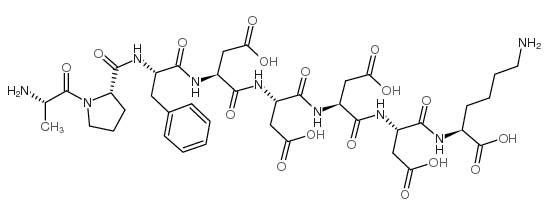胰蛋白酶原

胰蛋白酶原结构式

|
常用名 | 胰蛋白酶原 | 英文名 | trypsinogen |
|---|---|---|---|---|
| CAS号 | 9002-08-8 | 分子量 | 921.90400 | |
| 密度 | N/A | 沸点 | N/A | |
| 分子式 | C39H55N9O17 | 熔点 | N/A | |
| MSDS | 中文版 美版 | 闪点 | N/A | |
| 符号 |

GHS08 |
信号词 | Danger |
|
Leukocyte protease binding to nucleic acids promotes nuclear localization and cleavage of nucleic acid binding proteins.
J. Immunol. 192(11) , 5390-7, (2014) Killer lymphocyte granzyme (Gzm) serine proteases induce apoptosis of pathogen-infected cells and tumor cells. Many known Gzm substrates are nucleic acid binding proteins, and the Gzms accumulate in the target cell nucleus by an unknown mechanism. In this stu... |
|
|
Long-range electrostatic complementarity governs substrate recognition by human chymotrypsin C, a key regulator of digestive enzyme activation.
J. Biol. Chem. 288(14) , 9848-59, (2013) Human chymotrypsin C (CTRC) is a pancreatic serine protease that regulates activation and degradation of trypsinogens and procarboxypeptidases by targeting specific cleavage sites within their zymogen precursors. In cleaving these regulatory sites, which are ... |
|
|
Robust autoactivation, chymotrypsin C independence and diminished secretion define a subset of hereditary pancreatitis-associated cationic trypsinogen mutants.
FEBS J. 280(12) , 2888-99, (2013) Mutations in human cationic trypsinogen cause hereditary pancreatitis by altering its proteolytic regulation of activation and degradation by chymotrypsin C (CTRC). CTRC stimulates trypsinogen autoactivation by processing the activation peptide to a shorter f... |
|
|
Activation of cannabinoid receptor 2 reduces inflammation in acute experimental pancreatitis via intra-acinar activation of p38 and MK2-dependent mechanisms.
Am. J. Physiol. Gastrointest. Liver Physiol. 304(2) , G181-92, (2013) The endocannabinoid system has been shown to mediate beneficial effects on gastrointestinal inflammation via cannabinoid receptors 1 (CB(1)) and 2 (CB(2)). These receptors have also been reported to activate the MAP kinases p38 and c-Jun NH(2)-terminal kinase... |
|
|
Pharmacological inhibition of PAR2 with the pepducin P2pal-18S protects mice against acute experimental biliary pancreatitis.
Am. J. Physiol. Gastrointest. Liver Physiol. 304(5) , G516-26, (2013) Pancreatic acinar cells express proteinase-activated receptor-2 (PAR2) that is activated by trypsin-like serine proteases and has been shown to exert model-specific effects on the severity of experimental pancreatitis, i.e., PAR2(-/-) mice are protected from ... |
|
|
Cerulein-induced chronic pancreatitis does not require intra-acinar activation of trypsinogen in mice.
Gastroenterology 144(5) , 1076-1085.e2, (2013) Premature activation of trypsinogen activation can cause pancreatic injury and has been associated with chronic pancreatitis (CP). Mice that lack intra-acinar activation of trypsinogen, such as trypsinogen-7-null (T(-/-)) and cathepsin B-null (CB(-/-)) mice, ... |
|
|
Pancreatic fistulae secondary to trypsinogen activation by Pseudomonas aeruginosa infection after pancreatoduodenectomy.
J. Hepatobiliary. Pancreat. Sci. 22 , 454-62, (2015) Pancreatic fistula after pancreatoduodenectomy (PD) is associated with high mortality and morbidity. Trypsinogen activation and bacteria, although hypothesized to be interrelated etiopathogenetically, have not had their relationship and pathogenic mechanisms ... |
|
|
Early proteome analysis of rat pancreatic acinar AR42J cells treated with taurolithocholic acid 3-sulfate.
Pancreatology 12(3) , 248-56, (2012) Bile acids are the initiating factors of biliary acute pancreatitis. Bile acids can induce the activation of intracellular zymogen, thus leading injury in pancreatic acinar cells. Pathological zymogen activation in pancreatic acinar cells is a common feature ... |
|
|
Characterization of monoclonal antibodies using polymeric cation exchange monoliths in combination with salt and pH gradients.
J. Sep. Sci. 32 , 2668-73, (2009) The characterization of three different mAb formulations of pharmaceutical interest is demonstrated using cation exchange polymethacrylate-based monolithic columns as well as imaged CE (iCE). Elution of the mAbs from both a strong cation exchanger (ProSwift S... |
|
|
Thirty-years of screening for cystic fibrosis in East Anglia.
Arch. Dis. Child. 97(12) , 1043-7, (2012) Newborn screening for cystic fibrosis (CF) relies on the measurement of immunoreactive trypsinogen (IRT) originating from the pancreas. The Norfolk, Suffolk and Cambridgeshire screening programme initially exploited the persistent increase in IRT seen in CF (... |